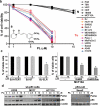Selective killing of cancer cells by a small molecule targeting the stress response to ROS
- PMID: 21753854
- PMCID: PMC3316487
- DOI: 10.1038/nature10167
Selective killing of cancer cells by a small molecule targeting the stress response to ROS
Erratum in
- Nature. 2012 Jan 26;481(7382):534
-
Corrigendum: Selective killing of cancer cells by a small molecule targeting the stress response to ROS.Nature. 2015 Oct 22;526(7574):596. doi: 10.1038/nature15370. Epub 2015 Sep 16. Nature. 2015. PMID: 26375002 No abstract available.
Retraction in
-
Retraction Note: Selective killing of cancer cells by a small molecule targeting the stress response to ROS.Nature. 2018 Sep;561(7723):420. doi: 10.1038/s41586-018-0284-y. Nature. 2018. PMID: 30046103 Free PMC article.
Abstract
Malignant transformation, driven by gain-of-function mutations in oncogenes and loss-of-function mutations in tumour suppressor genes, results in cell deregulation that is frequently associated with enhanced cellular stress (for example, oxidative, replicative, metabolic and proteotoxic stress, and DNA damage). Adaptation to this stress phenotype is required for cancer cells to survive, and consequently cancer cells may become dependent upon non-oncogenes that do not ordinarily perform such a vital function in normal cells. Thus, targeting these non-oncogene dependencies in the context of a transformed genotype may result in a synthetic lethal interaction and the selective death of cancer cells. Here we used a cell-based small-molecule screening and quantitative proteomics approach that resulted in the unbiased identification of a small molecule that selectively kills cancer cells but not normal cells. Piperlongumine increases the level of reactive oxygen species (ROS) and apoptotic cell death in both cancer cells and normal cells engineered to have a cancer genotype, irrespective of p53 status, but it has little effect on either rapidly or slowly dividing primary normal cells. Significant antitumour effects are observed in piperlongumine-treated mouse xenograft tumour models, with no apparent toxicity in normal mice. Moreover, piperlongumine potently inhibits the growth of spontaneously formed malignant breast tumours and their associated metastases in mice. Our results demonstrate the ability of a small molecule to induce apoptosis selectively in cells that have a cancer genotype, by targeting a non-oncogene co-dependency acquired through the expression of the cancer genotype in response to transformation-induced oxidative stress.
©2011 Macmillan Publishers Limited. All rights reserved
Figures




Comment in
-
Therapy: selective oxycution?Nat Rev Cancer. 2011 Aug 12;11(9):622-3. doi: 10.1038/nrc3127. Nat Rev Cancer. 2011. PMID: 21822209 No abstract available.
-
Anticancer Drugs: Selective oxycution?Nat Rev Drug Discov. 2011 Aug 31;10(9):658. doi: 10.1038/nrd3543. Nat Rev Drug Discov. 2011. PMID: 21878976 No abstract available.
References
-
- Yap TA, Sandhu SK, Carden CP, de Bono JS. Poly(ADP-ribose) polymerase (PARP) inhibitors: Exploiting a synthetic lethal strategy in the clinic. CA Cancer J Clin. 2011;61:31–49. doi:caac.20095 [pii] 10.3322/caac.20095. - PubMed
-
- Schumacker PT. Reactive oxygen species in cancer cells: live by the sword, die by the sword. Cancer cell. 2006;10:175–176. - PubMed
-
- Trachootham D, Alexandre J, Huang P. Targeting cancer cells by ROS-mediated mechanisms: a radical therapeutic approach? Nature reviews. 2009;8:579–591. - PubMed
Publication types
MeSH terms
Substances
Grants and funding
- RC2 CA148399/CA/NCI NIH HHS/United States
- UL1RR024924/RR/NCRR NIH HHS/United States
- P30 DK043351/DK/NIDDK NIH HHS/United States
- RL1HG004671/HG/NHGRI NIH HHS/United States
- R01 CA085681/CA/NCI NIH HHS/United States
- HHMI/Howard Hughes Medical Institute/United States
- CA080058/CA/NCI NIH HHS/United States
- R01 CA142805/CA/NCI NIH HHS/United States
- UL1 RR024924/RR/NCRR NIH HHS/United States
- 5 RC2 CA148399-02/CA/NCI NIH HHS/United States
- CA142805/CA/NCI NIH HHS/United States
- RL1 GM084437/GM/NIGMS NIH HHS/United States
- CA085681/CA/NCI NIH HHS/United States
- CA127247/CA/NCI NIH HHS/United States
- R01 CA127247/CA/NCI NIH HHS/United States
- RL1 HG004671/HG/NHGRI NIH HHS/United States
- RL1 CA133834/CA/NCI NIH HHS/United States
- RL1CA133834/CA/NCI NIH HHS/United States
- RL1GM084437/GM/NIGMS NIH HHS/United States
- P01 CA080058/CA/NCI NIH HHS/United States
- N01 CO012400/CA/NCI NIH HHS/United States
LinkOut - more resources
Full Text Sources
Other Literature Sources
Medical
Research Materials
Miscellaneous

